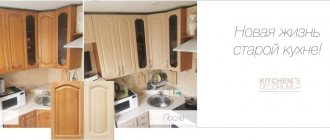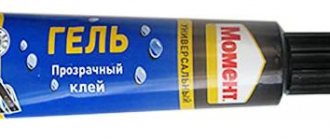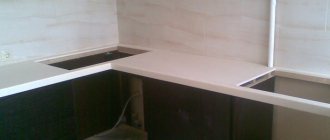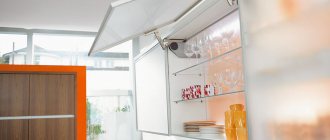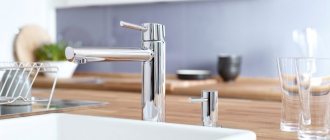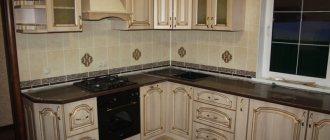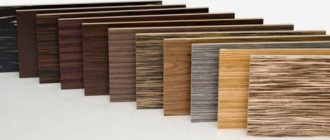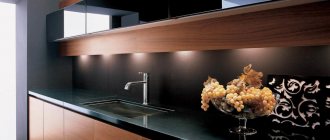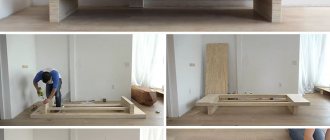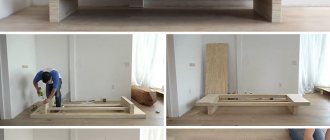Table of standard sizes of kitchen fronts
The idea of replacing, or, alternatively, restoring kitchen facades has several very tangible advantages, for example, when compared with buying a new kitchen set:
- Replacing the facade will cost an order of magnitude cheaper, even if you have to replace hinges, locks, part of the glazing and lighting along with the doors;
- There are a minimum of problems with installation, the design and arrangement of furniture in the kitchen does not change, there is no need to rack your brains with laying communications and wiring;
- The widest selection of colors, textures and materials used to replace the facade. You don’t have to select furniture in the showroom, but make its façade according to the location, the way the owners would like to see it.
The most important thing is that restoration by replacing the cladding and fittings of the facade greatly simplifies life; you do not need to get used to new furniture, break old habits and the order of storing food, appliances and utensils. Often, even innocent, but inconvenient innovations in the interior of the furniture in the kitchen cause wild irritation, to the point that the owners return old cabinets and tables to their place.
Sign for furniture connoisseurs
The kitchen, to a large extent, remains a work space, so almost all industrial furniture and the lion's share of hand-made kitchen furniture have long been produced in a line of standard sizes, developed by designers according to the criteria of ergonomics and aesthetics.
Most of the facades are designed based on dimensions adopted on the basis of human anthropological parameters:
- The height of the tabletop is determined in two heights: 85-86 cm for people up to 170 cm tall, 99-100 cm for average and tall people up to 185 cm;
- The vertical size of the front cabinets was made in three sizes: 57 cm and 72 cm for regular fronts, 92 cm for a standard kitchen and 95-98 cm for the newest layouts;
- The total height of the furniture is calculated for a person of average height - 185 cm and 200 cm.
In addition to the height of the tabletop and the general vertical, when selecting a façade, at least the dimensions of 6-7 more main pieces of furniture are used - hoods, pencil cases, hoods and built-in appliances.
If you plan to replace the façade at a serious level, not limiting yourself to gluing film or polishing wooden parts, information about the dimensions of the main furniture parts will be very useful. Instead of hand-fabricating a new door, you can use an off-the-shelf industrial part to repair a cabinet.
Selecting a frame color that matches the color of the new doors
The colors of the facades must be combined with the old frames. It happens that new facades have already been purchased, but the colors of the buildings are different.
One of three options is used:
- repainting;
- film update;
- dowel lining.
To avoid this situation, you need to buy white doors. They will fit any case.
The result of such a replacement of the kitchen facade is clearly visible in the photo.
DIY kitchen facades
Most kitchen furniture is made from chipboard, OSB and MDF boards lined with plastic, PVC film or wood veneer. Even with the most careful handling, the front surface of wall cabinets, drawers and pencil cases fades over time; the wood-effect pattern printed with paint loses its saturation and in some places becomes lighter due to regular washing. The kitchen furniture can only be restored by replacing the film covering of the furniture.
In addition to restoring or replacing the film-veneer cladding of the facade, repairs are usually carried out on auxiliary parts and components, without which normal use of kitchen furniture is practically impossible:
- Repair or replacement of door hinges, locks, clamps, pneumatic stops and opening angle compensators;
- Replace all external fittings, from decorative trims and handles to moldings and edgings covering the corner joints of glued veneer.
This is the main area of work, the quality of which determines the appearance of the kitchen facade. Replacing furniture coverings, handles and canopies will not require large expenses, the maximum is to buy material for cladding and fittings, and the result of restoration using this method almost always meets expectations.
Experts also recommend, when updating the kitchen facade, to inspect and replace the guide runners and roller supports of drawers and pencil cases. Often, due to wear and tear of the moving parts, the drawers “sag” on the supports, as a result, the lower tier under the tabletop takes on an unpresentable appearance.
Replacement and repair of antique wooden furniture facade
Solid wood furniture has always been the most expensive and most desirable for any kitchen. Even 40 years ago, the tabletop, doors of wall and drawer cabinets were made from one massive walnut, oak or beech board; the rest of the furniture could be made from laminated wooden planks and parts.
The plane of each door is cut with a “false” panel groove, then, after grinding and polishing the surface, all facade elements are installed on the furniture frame using reinforced piano canopies. Modern types of double-hinged hinges for cladding made from wide boards are, as a rule, not used; the doors turn out to be very heavy.
A complete replacement of solid wood kitchen cladding is resorted to only in exceptional cases when the surface cannot be restored by other means. In this case, doors, shelves or other kitchen furnishings are ordered from specialized companies that have special woodworking equipment.
Kitchen furniture, manufactured in the 50-80s of the last century, was assembled from veneer panels and chipboard sheets on durable wooden frames. In this case, you can order the production of a whole set of solid wood cladding to replace the old facade with a new, more expensive and beautiful one. True, most of the old canopies and position clamps will have to be replaced.
Production of paneled facades
The production technology of paneled facades involves the use of two main parts:
- Trims or frames made of laminated wood planks, which act as the frame or base of a paneled door;
- A canvas glued together from a wooden lath or MDF boards, chipboard, OSB and lined with veneer, paper or PVC film to resemble wood or a painted surface.
The external frame ensures the strength of the entire structure, so the facade is quite rigid, strong and durable. Most often, replacement comes down to restoring the decorative layer of varnish or paint and replacing the canopies, since paneled doors turn out to be massive and heavy.
Manufacturing of kitchen facades from wood
Approximately 70% of wood-look kitchen furniture facades are made using veneer and PVC film with a fiber texture pattern. The design is inexpensive, lightweight and, most importantly, very easy to replace the coating.
The veneer coating can be restored by replacing or sanding it yourself, it all depends on the condition of the facade and the degree of damage to the surface. If there are no signs of warping or peeling of the wood, the surface of the facade is sanded and coated with furniture varnish.
To completely replace the veneer, the main parts of the kitchen furniture are dismantled and sanded on a machine until the old lining layer is removed, after which a new cladding can be glued. High-quality furniture veneer requires certain skills in gluing the facade, so the work is often simplified. Instead of replacing veneer, the facade is covered with high-quality polyester or polyvinyl chloride film.
Production of kitchen facades from MDF
According to experts, light, durable and environmentally friendly facades made of MDF will in the future replace traditional furniture made of chipboard, plastic and even natural wood. The successful combination of using light cellulose fibers, hot stamping technology and the method of decorating the surface with polymer film provides a very reasonable price, low weight of the facade and an easy way to replace the decor.
To replace MDF facades, it is enough to remove the front panels, remove the outer decorative film layer and cover the surface with a new film. The material is easy to glue, drill, and cut, so if the old slab shows signs of delamination, burns, or cracking, the damaged area can be cut out and replaced with a patch of similar thickness.
MDF cladding can be successfully varnished, painted, polished and covered with any modern materials, from paper to veneer.
Kitchen fronts in aluminum frame
The use of aluminum profiles for the manufacture of frames and panels allows you to make a facade from any material, from pressed paper to natural wood, plastic and even stone.
Supporting structures are made from the profile, onto which all finishing elements, support runners, clamps and canopies are attached. Trim made of panels or plastic sheets is attached to frames. To replace the cladding, simply remove the fasteners and replace the old decor with new material.
Selection of restoration method and material
Painting changes the appearance. There are many colors and painting methods, the result depends on your imagination. The film is inexpensive, the sticker does not create problems. There are many colors and patterns. After restoration, the cabinets' resistance to moisture increases.
Replacing doors is more expensive, but the set looks like new. The price of replacing kitchen facades depends on their type.
Chipboard is a capricious material; high-quality ones last up to 10 years. In the absence of certificates, it deteriorates quickly. MDF (especially glossy) is much more attractive. Resistance to temperature changes and moisture is higher, cleaning is easier. Solid wood doors look great.
The glass also looks original. It can be smooth or corrugated, multi-colored, patterned or patterned. If the family has small children, it is better to use plexiglass. Metal is suitable only for high-tech and modern interiors. Rarely used as a replacement.
Moldings and fittings for the kitchen facade
With rare exceptions, most handles, latches, applied decorative tubular edges and lines of moldings used in furniture are made in a fairly large assortment of sizes, shapes and materials.
To update the fittings, you can select several design options for moldings, cabinet handles, decorative trims that best match the chosen style of the facade and the entire kitchen interior. It is clear that the fittings are installed on drawers and doors before the main finishing work is completed.
Decoration
At the end of the work, you need to secure the handles to the slats and doors.
There are quite a lot of paint options on the market, but not every composition is suitable for treating facades.
How to transform an old set
When the furniture has lost its visual appeal, but is still strong, without defects or breakages, you can decoratively update old facades without replacing them.
The film will decorate the facade of the kitchen.
- Pasting with film is the most common option for updating old furniture. To perform the work efficiently, the facades must be dismantled, washed, treated with degreasers and dried well, and then a film must be applied to the surface. It is important to do this correctly, otherwise bubbles under the film, distortion, and sloppy joints on visible surfaces will give a sloppy appearance.
- Old trims and doors can be painted. Preparation for work is the same as in the previous version. The paint must match the material to which it is applied, and its selection must be approached carefully. Solid wood can be varnished.
A spray bottle will help you quickly paint facades.
What to do if the film on the kitchen facade peels off
Problems with peeling PVC film can be solved in two ways - complete replacement of the external decorative coating and hot gluing of the old cladding.
In order to correct the situation when the film on the facade has peeled off, you need to clean the base, heat the polyvinyl chloride base with a hairdryer, apply quick-drying glue and rub the soft film onto the plywood or MDF board.
Bubbles on the kitchen facade are eliminated in the same way. The defective area is heated, pierced with a needle and a syringe filled with adhesive, and the film is rubbed onto the wooden base.
Working with MDF
The outer layer of decorative film is removed. In case of a damaged area (burn-through, delamination, cracking), this place is cut out and replaced with a patch of similar width. The surface of the slab is covered with a new film.
Take note! It is MDF boards that are successfully treated with paints, varnishes, films, polishing, and glue. Therefore, experiments with design painting or decoupage are great with them.
How to update kitchen facades
One of the best ways to restore kitchen furniture is to update and restore the old layer. Especially if the kitchen furniture is made of solid wood or lined with valuable wood veneer.
Decoupage of kitchen facades
The procedure for replacing the coating using the decoupage technique is considered the simplest and most affordable in terms of price and costs. All doors and drawers of the kitchen are first dismantled, the damaged areas are glued with patches, the holes for fastening the awnings are restored with wooden plugs, the hinges themselves are replaced with new ones of a similar design.
The essence of decoupage is to strip and remove the old coating and apply a new design or a whole series of different patterns and decorative options. Old varnish or paint is sanded off with sandpaper, polished with paste, cleaned and varnished. After the varnish has dried almost to the touch, it’s time to apply the drawings.
These can be images of various styles and forms, from newspaper clippings to fragments of paintings and wallpaper.
The designs glued to the varnish are coated with acrylic and polished to achieve a stable and uniform gloss.
Replacement of façade glazing
It is believed that the more glass and mirror surfaces are used in the furniture, the more spacious and elegant the kitchen space looks. Most often it is necessary to change the glazing of wall cabinets located above the sink and oven.
The material can be cut from sheet glass or you can buy a ready-made set from a glazier.
Polycarbonate or plexiglass is used only for the largest cabinets. At first glance, the idea of replacing ordinary glass with plexiglass looks attractive, but in practice, the appearance of such glazing lasts for a maximum of a year or two.
Covering kitchen facades with film
The fastest way to get your façade in order is with self-adhesive vinyl film. The only condition for obtaining high quality is careful preparation of the surface to be glued.
After removing the old film, the front part is sanded and cleaned, all defects and grains that can appear through the film coating are removed. To replace the cladding, you can use household furniture film with a wood texture or more expensive vinyl used for wrapping car bodies.
Painting kitchen facades
Painting of individual furniture parts is resorted to when it is necessary to create a rather complex kitchen interior by replacing it. For example, old antique furniture is repainted in colors that match the color scheme of the kitchen interior.
One of the best materials for repainting kitchen facades is acrylic automotive paint, used for body work and protecting rims. Most of the work on applying paint and varnish can be done directly in the kitchen without dismantling furniture parts.
The right choice of material for new doors
The durability and appearance of the furniture depend on the material.
The colors of kitchen facades can be almost any
There are enough options:
- Chipboard (the cheapest);
- plastic;
- MDF (painted or filmed);
- array;
- glass (plexiglass);
- metal;
- plastic.
Last option:
- practical;
- retains visual appeal for a long time;
- easy to care for;
- optimal in terms of cost/quality ratio.
Restoration of glossy coatings
There are two ways to restore gloss. In the classic version, the surface of cabinets and pencil cases is primed and machine polished using special compounds. In about half of the cases, it is possible to restore the gloss and even out the shine of the old varnish.
If the idea of replacing and polishing the old paintwork does not give the desired result, the furniture is disassembled into parts and painted with acrylic or pentaphthalic varnish using a machine sprayer.
Video: Restoration of kitchen cabinets
When restoring by painting, the surfaces are sanded and degreased. The paint is applied evenly and neatly. It is advisable to apply several layers of paint. It is important to wait until the previous layer has dried.
When covering with film, the doors are removed from their hinges and placed horizontally, all irregularities and nicks are removed. Be sure to degrease surfaces. For cutting the film, accurate measurements with a margin of 2 cm on each side are important. There should be no bubbles left when gluing. A roller is required for leveling. It is better to buy new accessories.
Taking measurements
The easiest option is to measure the old doors that you want to replace and find new ones based on their size. If for some reason this is not possible, the facades are selected to match the dimensions of the buildings. In this case, each door should have a height of 3 and a width of 4 mm less than the cabinet itself along the outer contour. This is the only way they won’t cling to each other when opening and rub against the countertop.
In order for the replacement of kitchen facades to be carried out with maximum precision, and for the set to look neat, it is necessary to carefully measure the distances from the edges to the mounting sockets for the hinges. Otherwise, the sashes will become uneven and the overall row will be disrupted.
Since not only the hinged doors will have to be replaced, but also the linings on the drawers, they should also be measured. Additionally, you will need to determine the distance from the outer edges to the walls of the box. This will allow the lid to be secured evenly and securely.
Decorate with mosaic
Mosaics from broken tiles are very easy to make with your own hands. The article “Creativity from leftover tiles” has a complete guide to action. Such a wardrobe or chest of drawers will look especially elegant in Mediterranean styles. You can also purchase ready-made mosaics in blocks.
What can you use to cover the tabletop?
What to cover the tabletop with? To do this, you will need a thick vinyl film with a self-adhesive backing; photo wallpaper is also suitable. How to do it: Pre-degrease the countertop surface and sand it for leveling. ... How to paint a kitchen countertop:
- Acrylic paint.
- Alkyd enamel.
- Water-based paint.
1 Dec.
2022 Interesting materials:
What is the difference between a lie and a fantasy? What is the difference between lettuce and leek? What is the difference between shelling peas and vegetable peas? What is the difference between a magnet and a family magnet? What is the difference between mania and hypomania? What is the difference between semolina brand M and brand T? How is manhwa different from comics? What is the difference between a marker and a liner? What is the difference between mung bean and peas? What is the difference between 5 in 40 oil and 5 in 30 oil?
Video: Example of a kitchen set with replaced doors - inside and out
It is not difficult to carry out restoration/replacement of doors yourself. No special tools or skills are needed. The materials are cheaper than new furniture. Family budget is saved. There is an opportunity to make the interior unique. Examples of replacing kitchen facades can be seen in the photo.
Those who are not confident in their abilities can invite specialists. When ordering a turnkey service, all stages of the work are performed by the contractor’s employees.
https://youtube.com/watch?v=I9EuKFlTQPk
Our house
An old Soviet wall can be transformed into modern and stylish furniture. It is enough to repaint the visible parts with the facades and rearrange the blocks - it is better to move them apart by inscribing photo wallpaper or a picture with a perspective in the center, or maybe draw a perspective on the wall and insert a TV:
Such objects from the 70-80s of the twentieth century still live in many apartments.
They are made well, they stand strong, but the appearance has long been outdated. Many doors are lopsided and do not close well, the facades are scratched and scuffed.
Master class: how to repaint a Soviet “wall”
If you are not ready to completely get rid of old furniture, then you can remodel and update it. The work is not easy, but the result is worth it!
Step 1. First, we completely disassembled the furniture. All fasteners, fittings and decorative elements were removed. To avoid confusion, all parts were numbered in accordance with the diagram. And sent for restoration.
Step 2. Next, you need to remove all defects and irregularities (chips, cracks, scratches). This is done using special pastes and primers, which, after application, are dried and sanded to a perfectly smooth surface.
Step 3. Now the parts are painted in the selected color. In this case it is light beige.
For painting, a spray gun is used, with which paint from a container under pressure is distributed over the surface in a thin, uniform layer. Neither a brush nor a roller can achieve such an effect!
Step 4. It is important to pack everything carefully and securely, and then installation - putting the “wall” back together
During installation, it’s time to replace old fittings and fasteners with new and modern ones. And don’t forget to put hinges with closers on the doors!
Below is my idea for upgrading the repainted wall:
Insert TV and picture/photo wallpaper/wall painting.
You can even insert a chair between wall fragments:
By the way, the wall in the top photo was simply refreshed by me in a deeper mahogany color
Glass doors can be frosted or decorated with patterns:
Specifically for the wall model above - if the central pencil case is moved to the left, then the sides for the shelves with glass doors will have to be made from the top plate of the cabinet - my husband has already done this, with a little skill in working with a saw and a drill, and you will get this style:
More ideas for other wall models:
In general, a symmetrical arrangement for light furniture is the most profitable classic option!
To change the style of facades to classic, just use moldings.
Dear decoupage artists, do you know a way to style a marble box? Here it is used on the doors!
Great luck if your old wall-chest-display has a symmetrical shape from the beginning. Then you will get very effective alterations:
Or you can even remove the doors at the wall, as is proposed in modern facades! but then it won’t be as functional:
It's still better with doors.
Did you like the article? Subscribe to the channel to stay up to date with the most interesting materials
Paint
Paint will be a real savior in furniture restoration. Before applying paint, sand the surface and coat with primer.
You can simply paint the cabinet in 1-2 colors, or you can paint a real picture on it. If you don’t have enough artistic skills for painting, you can make a drawing using a stencil. Geometric lines and shapes can be easily created using masking tape - it will serve as a smooth border for the paint. And for more complex patterns and pictures, the stencil will have to be made specially.
We talked about ways to transfer images to surfaces here: “The Happiness of Drawing on Walls.” And this link contains detailed instructions for using stencils: “Experiment: painting a wall using a stencil.”
Photo selection of kitchens with independent restoration/replacement of facades
An interesting option for facades made of wood or MDF is aging. The simplest option is staining. The old varnish is completely removed and a layer of stain is applied. The effect of antiquity is achieved by washing off the stain in certain areas (most often in the middle part of the canvas). After the doors have completely dried, they are sanded, and a second layer of stain made on a different base is applied to areas that should be darker. After drying, wax is rubbed along the fibers and the surfaces are sanded using a soft cloth.
When restoring by painting, you can apply a design with oil paints. It is important to apply paint smoothly and varnish.
